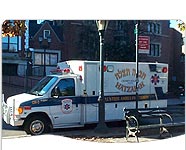 
The Heimlich in Near-Drownings
I used to like practicing the Heimlich maneuver when the procedure still included back blows. You picked
someone in the class you really weren’t fond of and made sure you were the second one to practice. But like
all things in EMS, the Heimlich is sometimes misapplied.
By Howard Rodenberg, MD, MPH, Dip (FM)
JULY 2004
Case Report
It’s a great day—sunny, temperature in the low 80s—until you’re dispatched to a drowning a couple of
hundred yards down the shore. On arrival, you see a young adult male lying supine by the surf with a lifeguard
administering a picturesque Heimlich maneuver. You stare incredulously. You and your partner look at each other,
the same question in your minds: A Heimlich maneuver?
Discussion
The Heimlich maneuver was a revolution in the management of the choking patient. It was easy, it made
sense, and (most importantly) it worked. As a result, people began to apply it to many different situations. One
such scenario is the near-drowning episode. (I use the term near-drowning because if you’ve drowned, you’re
already dead.) The theory: If the external application of positive pressure into the respiratory tree (what the
Heimlich actually does) clears hot dogs from the airway, why wouldn’t it clear seaweed, slime or water from
bronchi and alveoli? Not only would the maneuver clear the upper airway, but it might resolve alveolar obstruction
and improve oxygenation. To this day, the Heimlich maneuver is an integral part of care for near-drowning cases
in many EMS systems.
Let’s take a closer look at that theory. The Heimlich maneuver is based on air pressure. Application of the
Heimlich over the epigastric area drives the abdominal contents and, thus, the diaphragm into the chest cavity.
The pressure within the respiratory tree increases; if that pressure can’t be released, it presses against adjacent
objects and structures in an attempt to find a release point.
But the air pressure can exert its force only if it has something to press against. A tennis ball gun works because
the air in the gun exerts pressure against the solid tennis ball. Similarly, the Heimlich may remove a piece of meat
from the airway because meat is a solid object. But in the neardrowning patient, there is no solid, moveable object in
the airway to serve as a focal point for the pressure. Seaweed, mud and slime don’t form a firm surface against which
the air pressure can push. These materials are mobile and flexible, and can develop holes that allow the air to pass through.
The same characteristics that make the Heimlich problematic also explain why these organic materials are extremely
unlikely to cause airway obstruction in the first place.
What about alveolar obstruction by water aspirated into the lungs? After all, water does form a relatively firm barrier
to the passage of air, given enough depth. Shouldn’t the Heimlich help us get water out?
A look at the structure of the lung provides an initial answer to the question. The lung is made up of spongy tissue
that absorbs water into interstitial tissues. (Only when these tissues are saturated will you get free water in the alveoli.)
Excess water in the pulmonary tissues impedes the exchange of gas between alveoli and pulmonary capillaries. So in order
to enhance oxygenation, you’d have to squeeze out all the water from the interstitial space, which is asking a lot from a
series of single, quick compressions.
But there may actually be no water in the lungs. Consider the 10–20% of patients who exhibit “dry drowning,” in which
hypoxia results from laryngospasm. Any aspiration of water into the lungs is a result of post-hypoxic muscular relaxation.
(By the time the victim aspirates, they’re already unconscious from the hypoxic hit to the brain.)
Even when patients do aspirate water— and the majority of drowning victims aspirate less than 4 cc/kg—do we really
need to get it out? In the long term, yes. But in the short-term EMS environment, we routinely oxygenate patients with water
in their lungs. Remember that thing called congestive heart failure? It’s the same problem, and it shares the same prehospital
solution: oxygenation and ventilation.
The Heimlich may be ineffectual in drowning victims, but is it harmful? The maneuver does carry the risk of injuring
intraabdominal organs, but that is certainly acceptable when compared with the risk of prolonged hypoxia. However, protocols
that advise the use of the Heimlich for drowning victims often specify its performance within the first minutes of care and do so
irrespective of the actual presence of airway obstruction. The resultant delay in respiratory support makes the Heimlich a
dangerous use of time. JEMS
Howard Rodenberg, MD, MPH, Dip(FM), is director of the Volusia County (Fla.) Health Department. He has previously
served as medical director for Alachua County EMS and the ShandsCair Flight Program at the University of Florida. Contact
him via e-mail at AMDEMS@aol.com.
The views expressed here are solely those of the author and are not intended to be representative of the Volusia County
Health Department, the State of Florida or any other entity.
|









